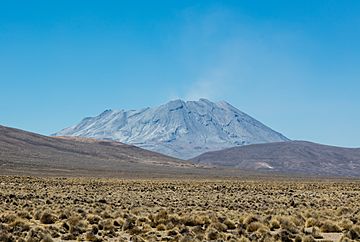Ubinas facts for kids
Quick facts for kids Ubinas |
|
|---|---|
| Uvillas or Uvinas | |

Ubinas in August 2015
|
|
| Highest point | |
| Elevation | 5,672 m (18,609 ft) |
| Naming | |
| English translation | Quechua: "to stuff", "to fill", "to grow", "to increase"; Aymara: "to weep", "to murmur" |
| Language of name | Quechua or Aymara |
| Geography | |
|
Lua error in Module:Location_map at line 420: attempt to index field 'wikibase' (a nil value).
|
|
| Parent range | Peruvian Western Cordillera, Andes |
| Geology | |
| Age of rock | Pleistocene-recent |
| Mountain type | stratovolcano |
| Volcanic belt | Central Volcanic Zone |
| Last eruption | 2019 |
Ubinas is a tall, cone-shaped volcano in southern Peru. It is about 60 kilometers (37 miles) east of the city of Arequipa. Ubinas is part of the Andes mountain range and stands 5,672 meters (18,609 feet) above sea level.
At the top of the volcano, there's a large, bowl-shaped dip called a caldera. This caldera is about 1.4 kilometers (0.87 miles) wide and 150 meters (490 feet) deep. Inside it, there's an even smaller crater. The volcano looks like it gets steeper as you go up, and it has a clear dip on its southern side. The lower, gentler part of the volcano is called Ubinas I, and the steeper upper part is Ubinas II. These names show different stages of how Ubinas formed over a very long time.
Ubinas is the most active volcano in Peru. It often has small to medium-sized explosive eruptions. It also had bigger eruptions, like one in 1667, and often releases ash. The volcano started forming a very long time ago, and the mountain we see today grew in two main steps. Its last eruption was in June 2019. Because it's so active, Ubinas is watched closely by the Peruvian geological service, INGEMMET. They have created a map showing dangerous areas around the volcano and regularly share reports on its activity.
Contents
What's in a Name?
The name Ubinas has interesting meanings from two local languages. The historian Mariano Felipe Paz Soldán explained these meanings.
- In the Quechua language, uina means "to stuff" or "to fill." Uiña means "to grow" or "to increase."
- In the Aymara language, hupi means "weep" or "murmur." Hupina is related to hupi.
Local people used to believe that Ubinas was a place where bad spirits and the souls of people who had lost their way from God lived. The volcano is also sometimes called Uvillas or Uvinas.
Weather and Plants
The weather around Ubinas changes a lot depending on how high up you are.
- At the very top of Ubinas, it's very cold. Temperatures often drop below 0 degrees Celsius (32 degrees Fahrenheit).
- Lower down, temperatures can go above 18 degrees Celsius (64 degrees Fahrenheit) during the day. However, it can still get cold enough for frost at night.
The area is generally dry. But during the summer wet season, heavy rains can cause landslides lower down. The upper parts of the volcano, including the caldera, can get covered in snow.
For example, in the town of Ubinas, which is at 3,200 meters (10,500 feet) elevation, the average temperature is about 9 to 11 degrees Celsius (48 to 52 degrees Fahrenheit). It gets about 300 to 360 millimeters (12 to 14 inches) of rain each year. Today, you usually find snow only above 5,400 meters (17,700 feet). But a very long time ago, during the Pleistocene Ice Age, snow covered areas as low as 4,900 meters (16,100 feet).
Plants and Animals
Different types of plants grow at different heights on Ubinas.
- Between 3,400 and 4,200 meters (11,200 and 13,800 feet), you'll find grasslands, bushes, and small trees in valleys.
- Higher up, between 4,200 and 4,700 meters (13,800 and 15,400 feet), there's a type of plant life called pajonal. This includes plants that grow close to the ground, different kinds of grasses, and shrubs that are common in high mountain areas.
- Small lakes and wet areas form wetlands called bofedales. Here, you can find aquatic plants and plants that grow in a circular shape. Both bofedales and pajonal also have cushion plants, which grow in dense, low mats.
- The very top of Ubinas has no plants at all.
Many animals live in the area, especially in the National Reserve nearby. These include various birds and camelids. Camelids are animals like alpacas, guanacos, llamas, and vicuñas.
How People Use Ubinas
In the 1800s, people mined Sulfur from the crater of Ubinas. These sulfur deposits were considered very important in Peru. People have also thought about using Ubinas as a place to produce geothermal energy. This is a type of energy that comes from the heat inside the Earth.
Images for kids
See also
 In Spanish: Ubinas para niños
In Spanish: Ubinas para niños




